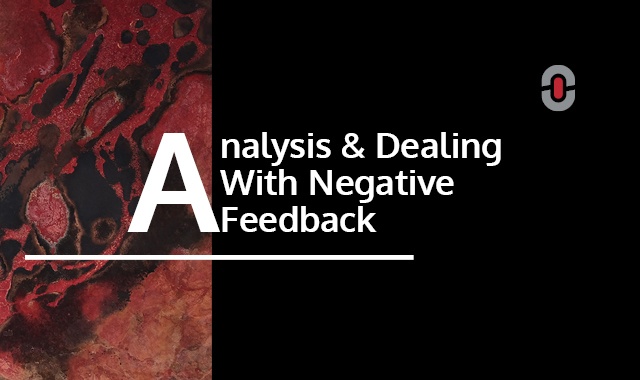Receiving criticism about your product or service can be heartwrenching because you put so much effort into it. But it does sometimes happen that there is a glitch and your customer decides to complain about the situation.
With online reviews serving as the modern-day version of word-of-mouth marketing, it’s essential that negative feedback and reviews are addressed as swiftly and efficiently as possible because this can have devastating consequences for your business.
In this blog article, you’ll find out more about why negative feedback is important and how sentiment analysis can be used to assist with addressing the impacts of negative feedback. You’ll also learn about a 1-Stop Asia case study and how we addressed a negative feedback situation. Let’s take a closer look.
Why negative feedback matters
Although it’s unpleasant to be on the receiving end of negative feedback, your thinking around this topic should be reframed for a few very important reasons. Negative feedback should be viewed as a gold mine. An opportunity to streamline your business, product, and/or service offering and to transcend and beat the competition. So, why exactly is negative feedback so important? Here are a few of the top reasons:
- It can impact your long-term revenue
- It can influence purchasing decisions and buying behavior, and
- It can have lasting effects on your business’ reputation
As such, organizations need to be on point when offering their customers the opportunity to give feedback and request assistance. This can be achieved through various coordinated and streamlined communication channels to boost the speed and efficiency of the negative feedback received and the steps taken to resolve it.
How to deal with negative feedback through sentiment analysis
The importance of swiftly addressing negative feedback cannot be overstated because it has such wide-reaching implications for every organization. But how can an organization deal with, process, and analyze this type of feedback? One of the answers lies in sentiment analysis.
Sentiment analysis takes communication and feedback from your customers and processes this “natural language” through machine learning. The “machine” then collates information about the feedback, automatically allocating values, picking up on patterns, etc. to give you an idea of what type of feedback you are dealing with – whether positive, neutral, or negative.
Of course, there is some feedback that is harder to interpret because it deals with many linguistic nuances and can sometimes be contradictory in nature. However, sentiment analysis is one of the most effective ways to monitor negative feedback from your customers about your organization and you can then find ways to resolve it.
Just a few of the benefits of sentiment analysis include the following:

- Monitor your online reputation: this can be achieved across multiple channels. Sentiment analysis tools can pool feedback from these channels together and then analyze it. This will help you identify different sources, topics, and trends related to the feedback and then enable you to measure the impact of your marketing, customer service, or public relations efforts.
- Respond to negative feedback: a timely response to negative feedback can be the difference between losing a customer or turning an unhappy customer into a loyal and happy one. Here, sentiment analysis can determine the nature of the feedback and suggest ways for you to resolve it. In short, the benefits of this are numerous because they show your customers that you care and that you are willing to improve your performance.
- Improve your products, services, or content: based on the insights and suggestions offered by your sentiment analysis tool, you can take this feedback to fine-tune your products, services, or content. Examples of this include determining common pain points or issues that your customers face when they interact with your product or service.
- Enhance your decision-making processes: sentiment analysis is also a highly effective way of helping provide you with data-driven, actionable insights to quantify and visualize the sentiment of the feedback you’ve received. You can also evaluate your performance over time and measure the impact of your efforts. Examples of these include decision-making changes to your marketing campaigns, customer service policies, etc.
- Offer greater emotional intelligence: with an accurate analysis of a negative feedback statement, you can also become more empathetic toward your audience and customers. Being able to respond in a respectful and empathetic manner is much more likely to win your customer back, who may be on the verge of choosing your competitor over you. Building trust is essential and your engagement with them will be much more meaningful.
A 1-Stop Asia case study in dealing with negative feedback
At 1-Stop Asia, we take all feedback from our clients very seriously and strive to limit this as far as possible while ensuring a strong customer service in the language, translation, and localization space. During the 2017/2018 period, we noticed that although negative feedback was on the decline, there were some language pairs for which we received high negative feedback. Examples of these language pairs include: EN-HI, DE-JA, IT-KO, EN-BN, and others.
Based on our thorough analysis, we determined that the most common errors made were from style or readability issues (over 26%), grammatical errors (approximately 39%), or missing or completely incorrect translations (over 11%). Of course, we realize that these errors can be highly costly across multiple projects and we took certain steps to ensure we limit this as much as possible.
Our action plan for addressing these issues included:
- Continued and regular analysis of feedback received
- Sharing the feedback with other team leaders to find better solutions to the problems
- Communication with various team members to request as much information as possible from clients without bothering them
- Pre-empt the feedback process by asking them what can be improved upon before the process begins
- Improve on the language pairs identified that were associated with negative feedback
- Create a list of translators, subjects, and a system for doing test jobs, and
- Ensure clear communication with all teams so that everyone is aware of what should be done.
Final thoughts
Although receiving negative feedback can seem like a daunting aspect to address, doing something about it as opposed to nothing can mean the difference between a loyal, happy customer and a disgruntled one who will not choose your organization to do business with. Sentiment analysis is one of the most effective ways to ensure that you identify trends and patterns and gain actionable insights into how to address such negative feedback.
Organizations should constantly strive to ensure that they are listening to their customers and making adjustments to their products, services, or even communication. This is an ongoing process that is constantly being fine-tuned and will require commitment from a number of teams to ensure effective outcomes and successful resolutions of issues.
